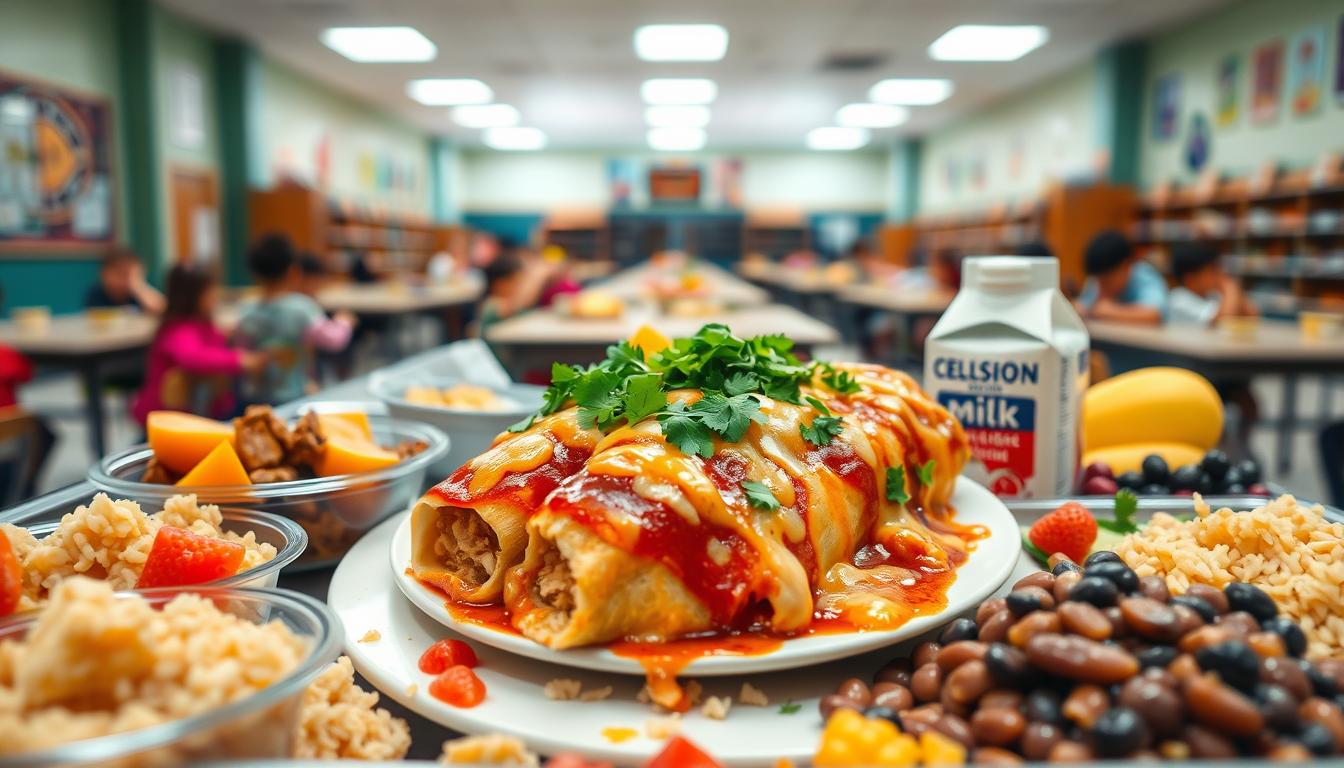Imagine you’re in the school cafeteria, looking for something tasty. You see “Enchiladas” on the menu and your mouth waters. Enchiladas are a mix of tender meat, gooey cheese, and zesty sauce in a soft tortilla. It’s why they’re a hit in school cafeterias everywhere.
For many, enchiladas bring back happy family dinner memories. They offer a sense of comfort and security at lunchtime. They’re also budget-friendly and easy to make, perfect for school kitchens.
Enchiladas come in many flavors, from beef to vegetarian options. They’re not just tasty; they’re also nutritious. They have protein, vitamins, and healthy tortillas, helping students stay energized.
Table of Contents
Enchilada School Lunch
The Popularity of Enchiladas in School Cafeterias
Enchiladas are a student favorite in school cafeterias across the United States. They combine tortillas, meat, cheese, and sauce in a way that students love. This makes them a top choice on school menus.
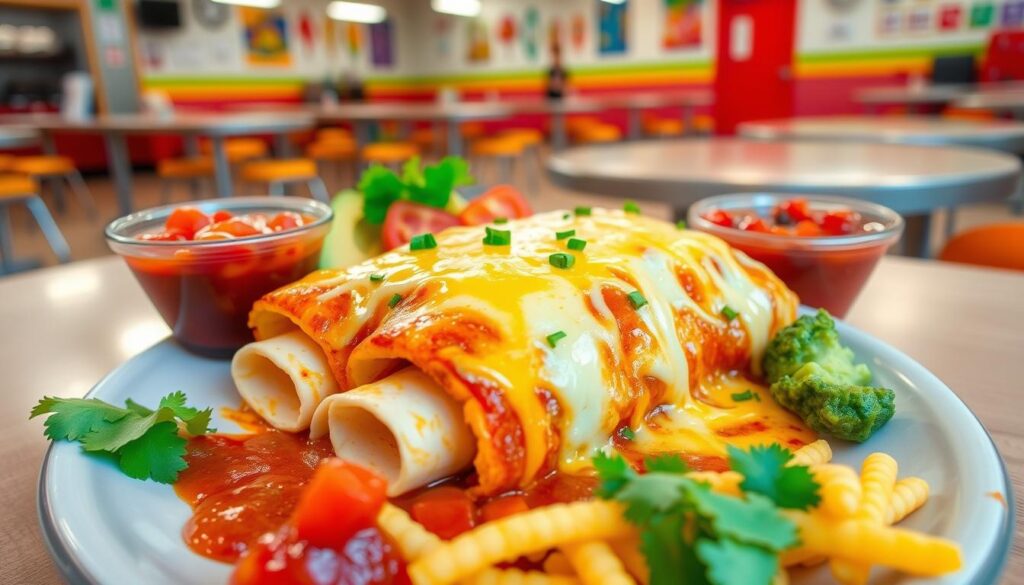
Why Students Love Enchiladas
Students enjoy enchiladas for their tasty flavor and comfort food appeal. The melted cheese, tender meat, and flavorful sauce make for a great meal. For many, enchiladas bring back childhood memories and family experiences, making them a comforting choice at school.
In San Antonio during the 1950s, schools made Wednesdays Enchilada Day. This led to the highest attendance rates on that day. Today, parents often join their kids for lunch on Wednesdays, showing how special Enchilada Day is.
Enchiladas as a Comforting and Familiar Meal
Enchiladas are a big part of TexMex cuisine. Restaurants often list “2 enchiladas, rice, and beans” as a top choice. Options like “Deluxe” enchiladas with a crispy beef taco and guacamole salad show their popularity. Even higher-level options, like “Mexican Dinner #2” or #3, include a queso chip, highlighting the dish’s appeal.
| Nutrient | Amount per Serving |
|---|---|
| Calories | 370 kcal |
| Carbohydrates | 35 g |
| Protein | 23 g |
| Fat | 16 g |
| Cholesterol | 60 mg |
| Sodium | 1440 mg |
| Fiber | 3 g |
| Sugar | 4 g |
Enchiladas are a favorite among students because they remind them of home and the love their parents put into preparing meals for special occasions.
Nutritional Benefits of Enchiladas in School Lunches
Enchiladas are a great choice for a healthy school lunch. They are full of protein, fiber, vitamins, and minerals. This makes them a well-rounded meal that kids will love.
Chicken enchiladas offer a good mix of nutrients. They include 2 oz of chicken, 2 oz of cheese, and a whole grain tortilla. This combination meets the nutritional needs of students.
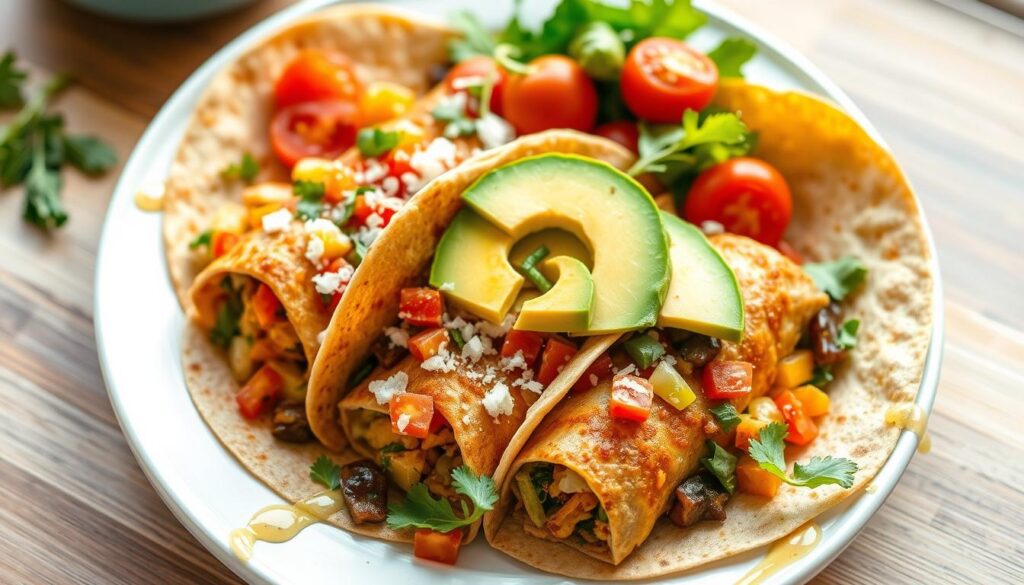
Enchiladas are also a good source of fiber, especially when made with beans and veggies. For example, Salsa Verde Chicken Enchilada Skillet has 37 grams of protein. It also has lots of fiber for a healthy gut and heart.
By using different ingredients, enchiladas can provide many vitamins and minerals. A recipe with onions, bell peppers, tomato sauce, and spices offers essential nutrients. This makes enchiladas a nutritious choice for school lunches.
| Ingredient | Quantity (50 servings) | Quantity (100 servings) |
|---|---|---|
| Cooked chicken breast | 6 lb | 12 lb |
| Cheddar cheese | 2 oz | 4 oz |
| Whole grain-rich flour tortillas | 50 tortillas | 100 tortillas |
Adding more veggies and whole grain tortillas can make enchiladas even healthier. With the right ingredients, enchiladas can be a tasty and nutritious part of school lunches. They give students the energy and nutrients they need to do well.
Adapting Enchiladas for School Cafeteria Menus
Introducing enchiladas to school menus is all about finding a balance. It’s about making them easy to prepare and appealing to kids. By simplifying the recipe and using flavors kids love, enchiladas can become a hit in cafeterias.
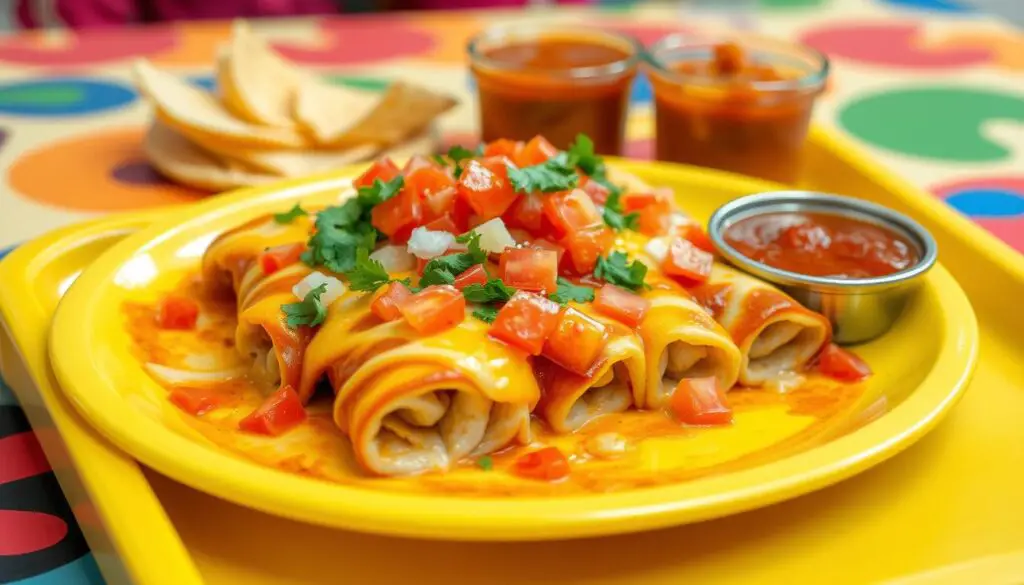
Streamlining the Preparation Process
To fit enchiladas into school kitchens, the recipe can be tweaked. Using pre-cooked chicken or beef saves time and keeps flavors rich. The beef enchilada recipe uses 40 lbs of ground beef, 10 chopped onions, and 10 green bell peppers.
The sauce can also be made simpler. A mix of canned tomato sauce, chicken broth, and spices like chili powder works well. This makes 2 gallons, perfect for big batches.
Incorporating Kid-Friendly Ingredients
To win over picky eaters, add ingredients kids enjoy. Mild salsa instead of spicy sauce is a good start. Toppings like cheddar cheese, onions, and green peppers add flavor without being too much.
Nutritional info per serving (two enchiladas):
| Nutrient | Amount |
|---|---|
| Calories | 693 |
| Fat | 43g |
| Saturated Fat | 16g |
| Carbohydrates | 37g |
| Sugar | 6g |
| Fiber | 6g |
| Protein | 41g |
| Sodium | 918mg |
| Cholesterol | 126mg |
Adapting enchiladas for school menus makes them a hit. They’re tasty, satisfying, and loved by students. Enchiladas are a great choice for school lunches, boosting satisfaction and reducing waste.
Beef Enchiladas: A Classic School Lunch Option
Beef enchiladas are a favorite among students for school lunches. They mix tender ground beef, zesty taco seasoning, creamy cheese, and soft flour tortillas. This combo makes for a filling meal that keeps kids going all day.
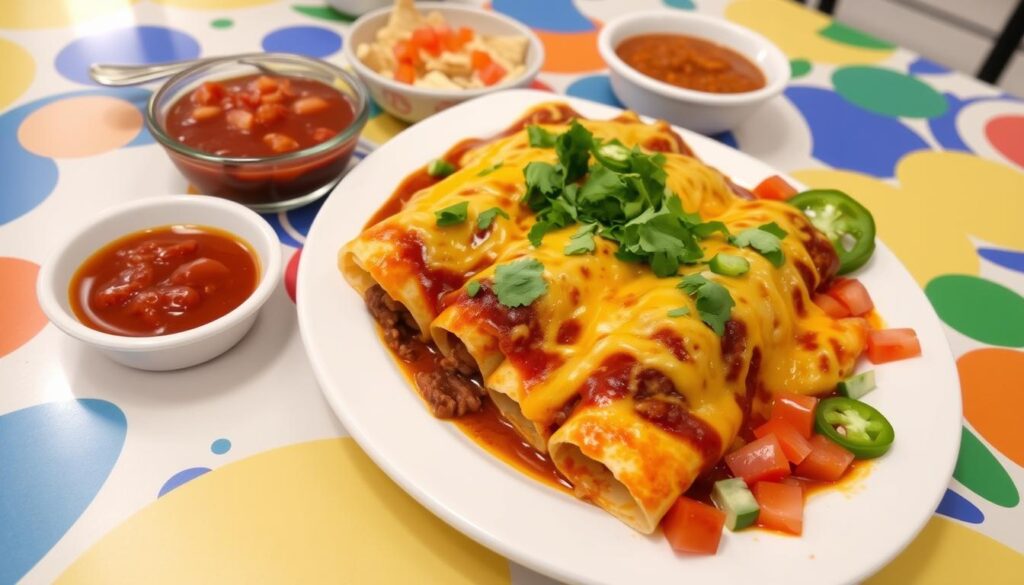
Traditional Beef Enchilada Recipe
A traditional beef enchilada recipe starts with lean ground beef. It’s best to use 90% lean beef for flavor without the grease. The beef is tenderized with baking soda for a softer texture.
The recipe takes about an hour to make. This makes it quick and easy for busy school kitchens.
The beef is seasoned with chili powder, cumin, and oregano. This gives it a unique Southwestern flavor. Cream cheese and shredded cheddar cheese add a rich, gooey texture.
| Ingredient | Amount |
|---|---|
| Lean ground beef (90% lean) | 1 pound |
| Taco seasoning | 1 packet |
| Cream cheese | 4 ounces |
| Shredded cheddar cheese | 1 cup |
| Flour tortillas | 8 large |
Enhancing the Flavor with Spices and Seasonings
School cafeterias can boost the flavor of beef enchiladas with spices and seasonings. Adding garlic powder, onion powder, and smoked paprika can deepen the taste. Topping with fresh ingredients like diced tomatoes and sour cream can also improve the dish.
Nutritionally, two beef enchiladas offer:
- Calories: 374
- Protein: 27g
- Fat: 18g
- Saturated Fat: 10g
- Cholesterol: 73mg
- Sodium: 940mg
- Carbohydrates: 26g
- Fiber: 4g
- Sugar: 7g
- Vitamin A: 639IU
- Vitamin C: 22mg
- Calcium: 413mg
- Iron: 4mg
To make a complete meal, school cafeterias often serve beef enchiladas with sides. Cilantro lime rice or Mexican rice are popular choices.
Vegetarian Enchilada Alternatives for School Lunches
More students are choosing meatless options, and school cafeterias are taking notice. They now offer vegetarian enchiladas as a tasty and healthy choice. These dishes are great for students with dietary restrictions and everyone else too.
Students love the summer vegetable enchiladas, giving it a 5 out of 7 vote. It serves 8 and is packed with nutrients. Each serving has 122 kcal, 17g carbs, 3g protein, and 3g fat.
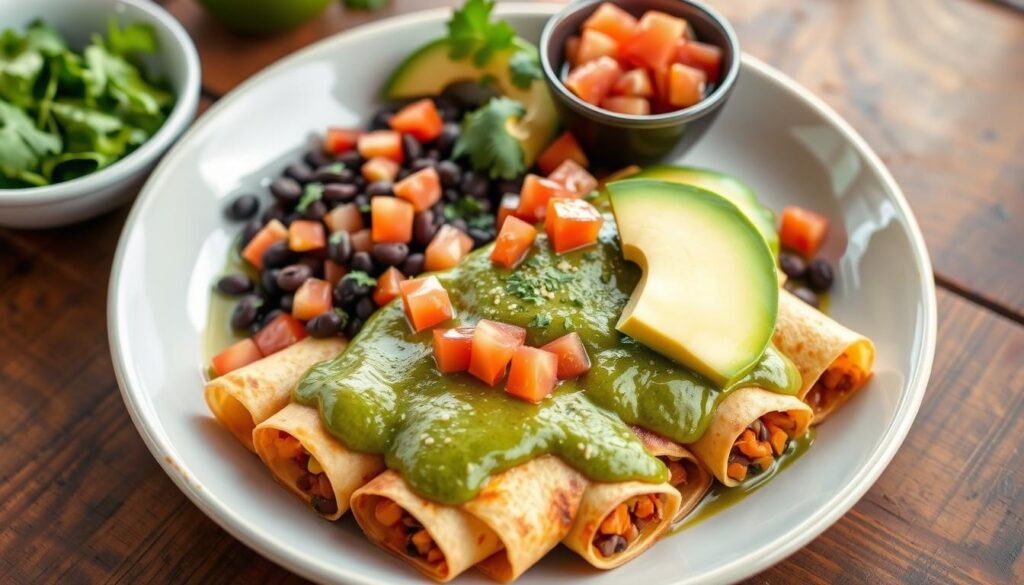
Cafeteria staff can make these enchiladas with many plant-based ingredients. They can use:
- Black beans for protein and fiber
- Sweet potatoes for vitamins and minerals
- Spinach for iron and antioxidants
- Corn for sweetness and crunch
- Tofu or lentils for more protein
A survey shows many students prefer vegetarian school lunches. Cafeterias can use ingredients like Morningstar Griller Crumbles and vegetarian refried beans. They can also use burrito-size tortillas and mild red enchilada sauce for a tasty meal.
Vegetarian enchiladas are not only a tasty and healthy choice for students but also a great way to encourage them to explore new flavors and embrace plant-based eating.
Cafeterias can make these enchiladas even better by offering toppings. They can have lettuce, tomato, sour cream, peppers, onion, guacamole, and cilantro. Vegan cheese and sour cream options are also available for students with dietary needs. These enchiladas are also great for leftovers or packed lunches, ensuring students have a nutritious meal all day.
Ensuring Food Safety and Hygiene in School Kitchens
Preparing school lunches, like enchiladas, requires top food safety. School kitchens must follow strict guidelines. This ensures students get safe, healthy meals. Keeping food at the right temperature and preventing contamination are key.
Adhering to Food Safety Regulations
Staff in school kitchens need to know food safety rules well. They must wash hands often and sanitize everything. Here are some important steps:
- Keep food at the right cooking temperature
- Use different cutting boards and tools for raw and cooked foods
- Clean and sanitize all surfaces and tools often
- Make sure staff wear gloves and hairnets when handling food
By following these steps, schools can lower the risk of foodborne illnesses. This way, students get safe, clean meals.
Proper Storage and Handling of Ingredients
Storing and handling ingredients right is crucial for food safety. Here are some tips:
| Ingredient | Storage Temperature | Maximum Storage Time |
|---|---|---|
| Fresh produce | 40°F or below | 7 days |
| Dairy products | 40°F or below | 7 days |
| Cooked meats | 40°F or below | 3-4 days |
| Dry goods | Cool, dry place | 6-12 months |
By keeping ingredients at the right temperature and using them before they expire, schools can serve fresh, safe meals. This includes their enchiladas and other dishes.
Balancing Taste and Nutrition in School Lunch Enchiladas
Creating tasty and healthy school lunch enchiladas is all about balance. By tweaking traditional recipes, you can make sure students get a meal that’s both filling and nutritious. This is key for their growth and health.
Using reduced-fat cheese, like cottage cheese, boosts the nutritional value of enchiladas. It’s packed with protein and low in fat. Plus, it’s a great source of calcium, vitamin B12, and riboflavin. A recipe with cottage cheese offers 26g of protein per serving.
Choosing low-sodium taco seasoning is another smart move. It cuts down on sodium without losing flavor. Also, switching to whole grain tortillas adds fiber and more nutrients to the dish.
It’s also important to control portion sizes in school lunches. This way, students get the right amount of nutrients without eating too much. The Cottage Cheese Chicken Enchiladas recipe makes 8 servings, perfect for school or family meals.
| Recipe | Protein (per serving) | User Rating | Prep Time | Cook Time | Servings |
|---|---|---|---|---|---|
| Cottage Cheese Chicken Enchiladas | 26g | 5 Stars | 10 minutes | 30 minutes | 8 |
Enchiladas are great because you can make them in many ways. You can offer vegetarian options or use different proteins. This way, every student can enjoy a meal that’s both tasty and healthy.
The key to creating healthy and delicious school lunch enchiladas lies in finding the perfect balance between taste and nutrition.
By choosing the right ingredients, controlling portions, and offering choices, you can give students a meal that’s not only delicious but also good for them. This supports their health and well-being.
The Role of Enchilada School Lunch in Promoting Cultural Diversity
Serving enchiladas in school lunches helps promote cultural diversity. It also opens students’ eyes to new tastes and traditions. By offering this Mexican dish, schools celebrate the rich heritage and flavors of Mexican cuisine.
Celebrating Mexican Cuisine in Schools
Adding enchiladas to school lunches is a great way to celebrate Mexican cuisine. It introduces students to vibrant flavors and ingredients. This creates a more inclusive and diverse dining experience, fostering cultural awareness and appreciation.
Here are some stats on the impact of cultural diversity in school lunches:
| Statistic | Impact |
|---|---|
| Enchiladas served as the daily lunch special on Wednesday | Regularly featuring enchiladas exposes students to Mexican cuisine |
| Cultural diversity celebrated with Hispanic Heritage Month | Dedicating time to celebrate Hispanic culture fosters cultural awareness |
| Emphasis on using local products showcased for Taste Washington Day and Farm to School month | Sourcing ingredients locally supports the community and teaches students about sustainable food systems |
Encouraging Students to Explore New Flavors
Offering enchiladas in school lunches encourages students to try new flavors. This exposure to global cuisines sparks curiosity. It makes students want to learn more about different cultures and their culinary traditions.
Trying new foods, like enchiladas, has opened my eyes to the incredible flavors and traditions of Mexican cuisine. It’s exciting to discover new dishes and learn about the cultures behind them.
Incorporating enchiladas into school lunches also offers a chance for food education. Teachers can use this dish to discuss the history, ingredients, and cultural significance of Mexican cuisine. This helps students appreciate the diverse culinary landscape around us.
Feedback and Ratings from Students on Enchilada School Lunches
Student satisfaction is key in school lunch programs. Schools hold taste tests and ask for feedback to keep enchiladas popular. This helps them improve their recipes.
Enchiladas are a hit in school cafeterias. Students love the flavors and can add their favorite toppings. With over 2,000 students, there’s something for everyone.
“I always look forward to enchilada day at school. It’s one of my favorite lunches, and I love how I can add my own toppings to make it just the way I like it.”
Schools mix it up with different enchilada types. They change the menu a little each month. Students can check the school website for the latest menu.
| Day | Enchilada Type | Student Satisfaction Rating |
|---|---|---|
| Monday | Beef Enchiladas | 4.5/5 |
| Wednesday | Vegetarian Enchiladas | 4.2/5 |
| Friday | Chicken Enchiladas | 4.7/5 |
By listening to students, schools keep enchiladas a favorite. This makes lunchtime better and encourages healthy choices.
Partnering with Local Suppliers for Fresh Ingredients
School cafeterias are now using local sources for meals. They work with farmers and businesses to offer healthy, tasty lunches. This helps the local economy and ensures top-quality ingredients.
Supporting Local Farmers and Businesses
Farm-to-school programs help schools get fresh produce from local farmers. These partnerships are good for students’ health and local businesses. They also cut down on costs and carbon emissions.
In California, schools team up with local farms for their meals. This program teaches students about local agriculture and sustainable food. It also gives them healthier options.
Ensuring Quality and Freshness of Ingredients
Local sourcing means schools get the freshest ingredients for their enchiladas. This approach keeps nutrients and flavors in the food. It’s key for veggies and herbs in enchiladas.
Working with local suppliers also lets schools control ingredient quality. They can talk directly to farmers to meet their standards. This ensures the food is organic or free from allergens.
In summary, partnering with local suppliers benefits everyone. Schools get fresh, healthy meals, and the community gets support. It’s a great way to promote sustainable food systems.
Conclusion
School lunch enchiladas are a favorite in many U.S. cafeterias. They offer students a comforting meal that boosts well-being and nutrition. By adding enchiladas to menus, schools encourage students to try new tastes and learn about Mexican cuisine.
For enchilada lunches to be tasty and healthy, schools must balance flavors and nutrition. They use fresh, local ingredients and follow food safety rules. This way, schools support their community and give students the best for their meals.
The success of enchilada lunches in schools is clear. They fill students’ bellies and help them stay healthy. By offering these meals, schools help students develop good eating habits for life. As school cafeterias keep improving their enchilada recipes, these lunches will stay a hit with students.
How Was Your Experience? Share Your Review!
There are no reviews yet. Be the first one to write one.

